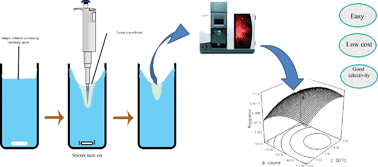Speciation and determination of Cr(iii) and Cr(vi) by directly suspended droplet microextraction coupled with flame atomic absorption spectrometry: an application of central composite design strategy as an experimental design tool
Abstract
A simple speciation and preconcentration of trace levels of Cr(III) and Cr(VI) in water samples have been performed using the directly suspended droplet microextraction (DSDME) method prior to its determination by flame atomic absorption spectrometry (FAAS). In this study, samples with Cr(III) and Cr(VI) and sodium diethyl dithiocarbamate (Na-DDTC) was pH adjusted and then 1-octanol placed on top of the vortex. Chromium speciation was based on the complex formation reaction of Cr(VI) with a chelating agent in the pH range of 1–6. After preconcentration, the extraction solvent was removed by a micropipette prior to injection to the FAAS introduction system. Experimental parameters affecting the directly suspended droplet microextraction performance, such as size of drop, extraction time, pH, stirring speed, extraction time and type of extraction solvent, were investigated. In order to obtain the global optimum conditions and also for increased accuracy, the most important parameters were chosen for evaluation by response surface methodology (RSM). Finally, the injection of 100 microliter of analyte-containing extraction solvent supplied a very reproducible response in the peak area mode. Cr(III) was calculated after reaction with KMnO4 in the presence of an acidic solution and subtracting from the amount of Cr(VI) that has determined in a previous step. Under optimum conditions, limits of detection (LOD) of Cr(III) and Cr(VI) were 1.2 and 1.8 ng mL−1, respectively. The calibration graphs were linear in the range of 3–90 ng mL−1 for Cr(VI) (R2 = 0.9911) and 5–110 ng mL−1 for Cr(III) (R2 = 0.9844). Thermodynamic parameters affecting the extraction phenomena were studied. Relative standard deviations (RSD) were 5.8% and 6.1% for Cr(III) and Cr(VI), respectively. The presented method has been performed on tap and river water analysis with satisfactory results.


 Please wait while we load your content...
Please wait while we load your content...